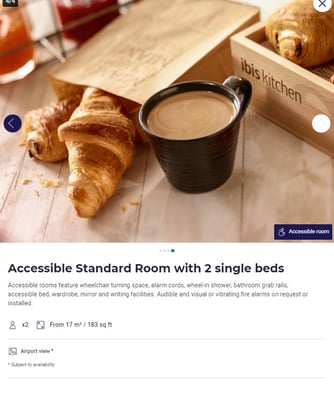For many, being compliant with the Web Content Accessibility Guidelines (WCAG), the international standard of digital accessibility, is seen as the key step towards meeting the needs of users with access requirements. While it is a good start, it is not the end of the journey.
A WCAG compliant website may still not be accessible.
This is because users with access requirements might have different needs that are not being met.
How a WCAG compliant website might not be accessible
An example. My mum suffers from Multiple Sclerosis and is in a wheelchair. When she is booking a hotel room, she has certain very specific questions that need to be answered. How wide are the doors? How much space is there down the right-hand side of the bed? Are the bathroom grab rails in a specific orientation around the toilet? Is there a shower seat available?
It is a long and exhaustive list and 9 times out of 10 these are not answers that can be obtained from a hotel’s website.
Take, for example, the below details from an Ibis hotel chain (specifically their Luton branch). They have gone some way to supporting the needs of users with access requirements by highlighting their accessible room and the features they include, “wheelchair turning space, alarm cords, wheel-in shower, bathroom grab rails, accessible bed, wardrobe, mirror and writing facilities”. We then get 4 pictures, 3 of the bedroom, 1 of a croissant and none of the bathroom. From these pictures, my mum would not be able to establish if this room is right for her.


Instead, she would have to spend lots of time on the phone, trying to understand the specific set up of rooms to work out if a stay in the hotel is going to be feasible.
For my mum, this website is not accessible i.e. it does not give her the information she needs to confidently book a hotel room.
But it could be. Lots more images, including some of the bathroom showing the promised ‘grab rails’, and a floorplan that gives some dimensions of the ‘wheelchair turning space’, and she would be much better informed to make a decision about the room and perhaps even book it.
Clearly, this is just one example of an individual’s needs not being met by a specific website. However, her frustrations are likely to be representative of a much larger group of users, for example anyone with similar mobility issues, the elderly or individuals with young children in prams, and the impact of meeting these needs more effectively much broader.
How to achieve genuine digital accessibility
The only way to establish if a website is genuinely accessible is to undertake testing with representative users.
The WCAG will establish if the content is technically accessible, for example, whether images have alt text or the colour contrast makes it perceivable, but it will not tell you if the images you have chosen meet the needs of all your users.
This testing should be undertaken 1-2-1 with target users. This can be done face-to-face or remotely but should establish if these individuals can use the site and whether the content they find allows them to achieve their goals - in this case, booking a hotel room.
The WCAG is a great starting point for organisations on their accessibility journey but do not think that compliance with the guidelines is the end game. Talk to your users, find out what they want and see the positive impact that this inclusion will have on everyone that uses your website.
Read more:
Digital exclusion and online accessibility


